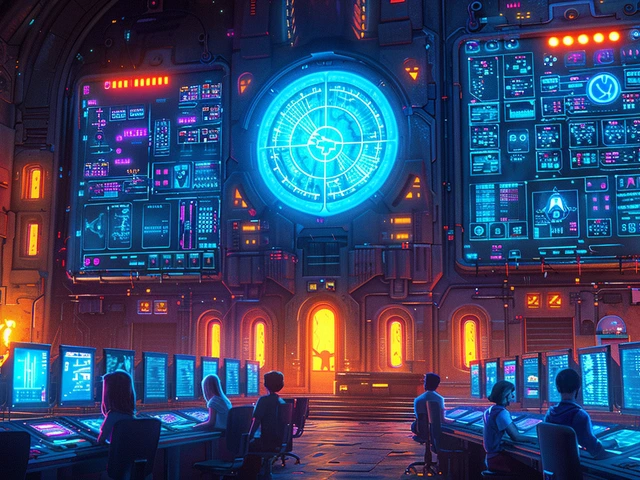Jan
11

- by Harrison Dexter
- 0 Comments
Why Python Reigns Supreme in AI
Have you ever wondered why Python is to AI what spinach is to Popeye? Well, it all starts with Python's simplicity and elegance. I remember the time I tried explaining Python to my kids, Fredrick and Nadine—I likened it to LEGO, where you can build pretty much anything with a few basic blocks. But it's not just the simplicity that makes Python awesome for AI. The language's vast repositories of libraries and frameworks, and its incredible community support, make it the go-to choice for developers. When you're working on something as intricate as AI, you need a language that doesn't make you want to pull your hair out.
Python's Libraries: Your Treasure Trove for AI
If you're diving into the AI world, Python's libraries are like your trusty Swiss Army knife. Tools like NumPy, Pandas, and Matplotlib help with heavy-lifting data tasks, while libraries like TensorFlow, Keras, Scikit-learn, and PyTorch are akin to finding a genie in a bottle for machine learning tasks. I mean, who doesn't like a good shortcut to success, right? These libraries come packed with features that help in developing complex AI algorithms without having to reinvent the wheel or, in this case, the neural network.
Frameworks: The Skeletons Behind the AI Bodies
Frameworks in Python are what give AI its shape and form. Think of them like the skeletal system in the human body—they provide structure and support. On a more relatable note, remember the time you tried setting up a tent without the poles? A crumpled mess, right? Exactly! Frameworks like Django and Flask come to the rescue when you're building web applications with AI capabilities. They help keep your AI models sturdy and functional, and believe me, nobody wants a flimsy AI.
Python's Syntax: Readability Meets Functionality
Now, Python's syntax is a breath of fresh air, especially if you've ever had to look at code that resembles alphabet soup. It's so easy to read that sometimes when I'm reading Python scripts late at night, it almost feels like I'm reading bedtime stories to Fredrick and Nadine. And in the cold, logical world of programming, a language that's as intuitive as Python is like having a warm blanket around you. It means you spend less time deciphering code and more time actually building stuff.
Community and Resources: Python's Secret Sauce
One of the things that really sets Python apart is its vibrant community. I cannot tell you how many times I've found solutions to my coding problems in community forums or through a helpful Pythonista's blog post. The wealth of resources available is like having your own personal coding library at your fingertips. And with the community constantly contributing to the ecosystem, Python for AI is like a well-oiled machine that just keeps getting better with age.
Machine Learning with Python: A Match Made in Heaven
I've played with machine learning a fair bit, and I can say without a doubt, Python and machine learning are like peanut butter and jelly—it just fits. Machine learning applications can be quite complex, but Python's simplicity helps make this complexity manageable. It's like when my daughter Nadine tries to solve a puzzle; she starts with the corners and edges to form the framework, and then fills in the middle. That's what Python's libraries do for machine learning. They help you outline the edges so you can focus on the fascinating world inside the puzzle.
Deep Learning Takes Flight with Python's Wings
Now, if machine learning is an art, deep learning is masterpiece-level stuff. And guess what? Python is the artist's favorite brush here as well. Deep learning algorithms require a lot of intricate work, kind of like when you're trying to capture the essence of a sunset on canvas. You need the right tools, and Python's deep learning libraries like Keras make it possible to paint that sunset without having to mix every possible combination of red, orange, and purple on your palette.
AI in Data Science: The Power Duo
Let's switch gears and talk about data science—AI's best buddy. Data is like the sandbox where AI children play and build castles—or in this case, predictions and decisions. Python's role in data science has become as common as a flat tire on a bike trail here in Austin—it's everywhere, and that's a good thing! With Python's data manipulation and analysis capabilities, you can turn mountains of raw data into actionable insights. It's like having an excavation machine in an archaeological dig; you find treasures that were hidden just beneath the surface.
Real-world AI Solutions and Python
Lastly, let's get real. AI isn't some sci-fi movie prop—it's here, and it's changing the world. Python is the craftsman's tool, shaping AI to fit into our daily lives. Be it healthcare, financial services, or even gaming, AI solutions powered by Python are like a well-placed mirror, reflecting the future into our present. Just think about the recommendation systems on streaming services—they know you so well, it's almost spooky. That's Python for you; it understands your needs and serves up personalized technology on a silver platter.






Write a comment